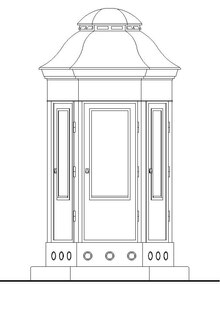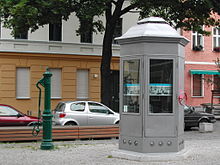Line splitter
In Linienverzweiger (LTR) main strands were further fanned the underground cable network of the German postal and telegraph administration in the early 20th century to the distribution systems. The line distributor provided the connection points in a room accessible above ground. The line splitters were advantageous in the construction phase of the cable networks that were established in Berlin, for example, from 1901, since fewer reserves had to be kept in the incoming lines. Only in the further branches were reserve wires available for further expansion.
Line splitters are no longer in use today. Their function has been replaced by cable distributors . A reconditioned copy of a line splitter that was shut down in 1992 is on Tuchollaplatz in Berlin-Rummelsburg . Another line distributor from 1928, which was in Dresden until 1994, is part of the Hohenloher Freilandmuseum Wackershofen , which shows an exhibition on telecommunications technology in a building.
Technical use
In the manual dictionary of electrical telecommunications in 1929, line splitters were identified as follows:
Line distributors (cable distribution box; chambre de concentration) are used to combine the cables coming from the cable distributors and to route the operating lines to the distribution point while saving supply lines. They differ from the cable distributors only in their size. In order to enable better work on the terminations, the terminations are arranged in line distributors for roads in such a way that they can be worked on from an interior. "
The operating conditions for line splitters in the distribution system of the responsible Deutsche Reichspost were described in a technical article in 1912:
“The steadily growing number of telephone connection lines means that above-ground wiring is increasingly being replaced by cables. For years, switching systems have therefore been in use at various post and telegraph administrations in order to route and distribute the connection lines completely or partially underground and to only need to provide the reserve required in every cable network in the last foothills of the network. In the Reichspost distribution system, a series of multi-pair main cables lead from the headquarters to a so-called line splitter from which cables with around 25 to 50% more wire pairs start, which are gradually divided into weaker cables and end in so-called cable splitters. From the cable distributors, distribution cables containing up to 100% more wire pairs lead to the so-called end distributors, in which the single-pair connection cables leading to the individual subscribers end. "
Line splitter on Berlin's Tuchollaplatz
restoration
The clearing and scrapping of the last remaining line distributor on Hauptstrasse / Kynastbrücke in Berlin was foreseeable with the start of extensive urban redevelopment work in the vicinity of Ostkreuz station . The above-ground components were provided free of charge by Telekom, they could be salvaged and restored. Financing was made possible with funds from “ Art in Architecture ”, as the town square in the Victoriastadt residential area was restored with funds from the urban monument protection scheme. The initiative for the line splitter was supported by the local residents' representatives, who preferred interactive street furniture to historicizing sculpture. It was carefully restored in a metal workshop, and glass panes were installed in three of the six doors, which can also be opened if necessary. The original work stool (sticker " Oberpostdirektion Berlin "), the switching strips and the solar panels for lighting during the night form the basic equipment.
Current usage
The line distributor was set up in 2003 on Tuchollaplatz in Berlin-Rummelsburg. It got its new location 700 m as the crow flies east of the original location on a town square with a new function as a town showcase and gallery.
It offers space for exhibitions by artists based in the quarter, for workshop portraits, art installations for the location and productions that temporarily use the object, such as street theater and open-air workshops.
Between 2003 and 2013 it was a screening room for an open-air cinema on the town square six times; 15 art installations took place in random order.
Web links
literature
- ^ A. Feyerabend: Short dictionary of electrical telecommunications . Berlin 1929, p. 57, 58 .
- ↑ A. Ebeling and R. Deibel: Switchgear with constant high insulation for the distribution networks of post and telegraph administrations . In: Telegraph- u. Telephony technology, supplement to the sheets for post and telegraphy, 1st year, issue 15 . Berlin 1912.
Individual evidence
- ↑ Bayern-online: Line splitter in the Hohenloher open air museum in Wackershofen
- ↑ Urban development Berlin: conversion of the Tuchollaplatz
- ↑ Berliner Zeitung: Kunst im Linienverzweiger - Berlin's smallest gallery has two square meters and a past , October 25, 2003



